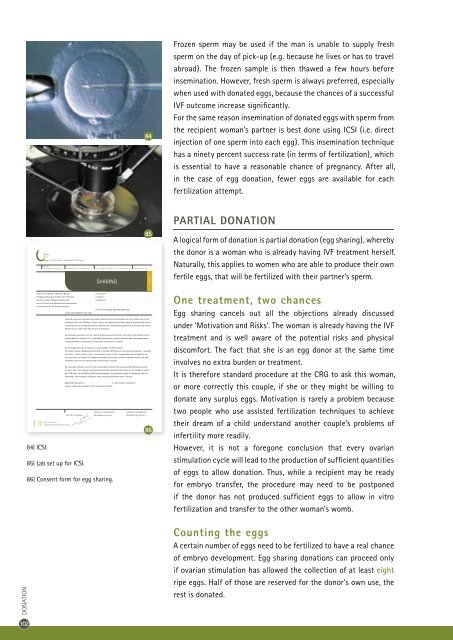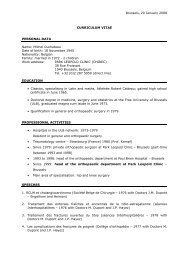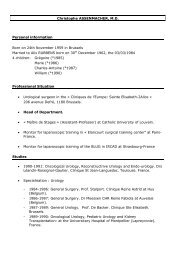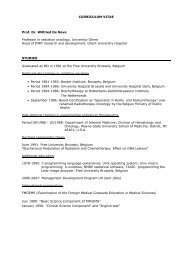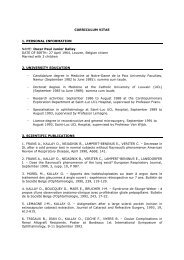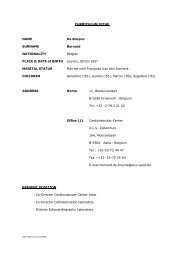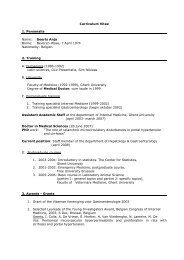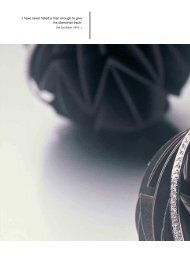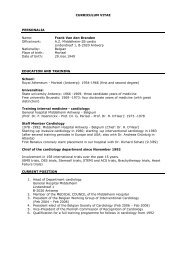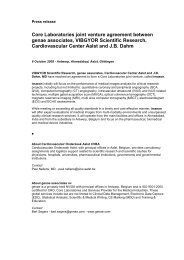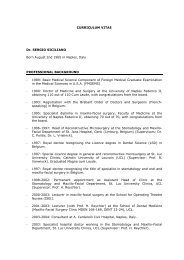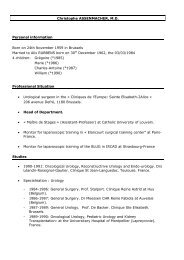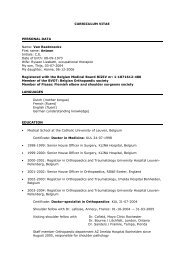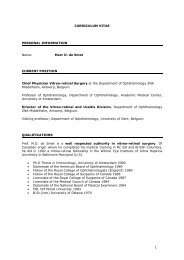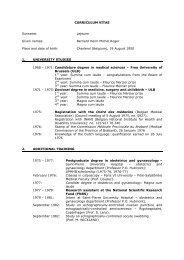Download PDF - HealthCare Belgium
Download PDF - HealthCare Belgium
Download PDF - HealthCare Belgium
Create successful ePaper yourself
Turn your PDF publications into a flip-book with our unique Google optimized e-Paper software.
84<br />
Frozen sperm may be used if the man is unable to supply fresh<br />
sperm on the day of pick-up (e.g. because he lives or has to travel<br />
abroad). The frozen sample is then thawed a few hours before<br />
insemination. However, fresh sperm is always preferred, especially<br />
when used with donated eggs, because the chances of a successful<br />
IVF outcome increase significantly.<br />
For the same reason insemination of donated eggs with sperm from<br />
the recipient woman’s partner is best done using ICSI (i.e. direct<br />
injection of one sperm into each egg). This insemination technique<br />
has a ninety percent success rate (in terms of fertilization), which<br />
is essential to have a reasonable chance of pregnancy. After all,<br />
in the case of egg donation, fewer eggs are available for each<br />
fertilization attempt.<br />
<br />
<br />
<br />
<br />
<br />
<br />
<br />
<br />
<br />
<br />
<br />
<br />
84| ICSI.<br />
85| Lab set up for ICSI.<br />
86| Consent form for egg sharing.<br />
85<br />
<br />
<br />
<br />
<br />
<br />
<br />
<br />
<br />
<br />
<br />
<br />
<br />
<br />
<br />
<br />
<br />
<br />
<br />
<br />
<br />
<br />
<br />
<br />
<br />
86<br />
PARTIAL DONATION<br />
A logical form of donation is partial donation (egg sharing), whereby<br />
the donor is a woman who is already having IVF treatment herself.<br />
Naturally, this applies to women who are able to produce their own<br />
fertile eggs, that will be fertilized with their partner’s sperm.<br />
One treatment, two chances<br />
Egg sharing cancels out all the objections already discussed<br />
under ‘Motivation and Risks’. The woman is already having the IVF<br />
treatment and is well aware of the potential risks and physical<br />
discomfort. The fact that she is an egg donor at the same time<br />
involves no extra burden or treatment.<br />
It is therefore standard procedure at the CRG to ask this woman,<br />
or more correctly this couple, if she or they might be willing to<br />
donate any surplus eggs. Motivation is rarely a problem because<br />
two people who use assisted fertilization techniques to achieve<br />
their dream of a child understand another couple’s problems of<br />
infertility more readily.<br />
However, it is not a foregone conclusion that every ovarian<br />
stimulation cycle will lead to the production of sufficient quantities<br />
of eggs to allow donation. Thus, while a recipient may be ready<br />
for embryo transfer, the procedure may need to be postponed<br />
if the donor has not produced sufficient eggs to allow in vitro<br />
fertilization and transfer to the other woman’s womb.<br />
DONATION<br />
Counting the eggs<br />
A certain number of eggs need to be fertilized to have a real chance<br />
of embryo development. Egg sharing donations can proceed only<br />
if ovarian stimulation has allowed the collection of at least eight<br />
ripe eggs. Half of those are reserved for the donor’s own use, the<br />
rest is donated.<br />
102


